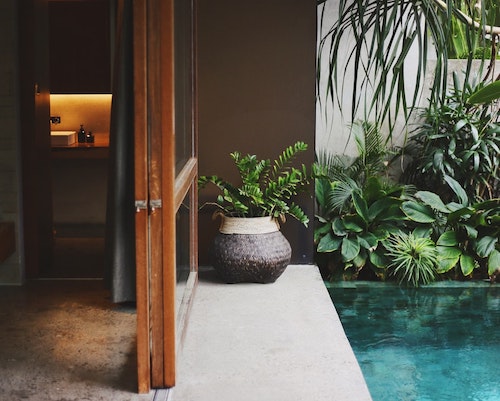As humans living in a modern world, we spend the vast majority of our time indoors. However, we also enjoy being outdoors as well, which is why ideal homes are found close to nature, for example, on a riverfront.
Most of us, however, can’t afford the luxury of living in that perfect home by the lake. We review our finances and settle for an apartment in the city or a small house in a rural town. The fact that you don’t yet have your dream house doesn’t mean you can’t make it out of your current home. With biophilic design, you’ll feel close to nature while still in the comfort of your home.
Biophilic design is a method that brings nature into your home through landscaping and architecture. Its aim is to reduce the sharp boundaries between traditional architecture and the outdoors, creating a harmonious environment where you can feel both at ease and safe at once.
Whether you live in that house by the lake or a small city apartment, there are a few fundamentals of biophilic design that you can use for inspiration. Here are a few ideas for design inspiration/design stories to get you started.
- Let the Air In
- Make Use of Natural Light
- Let Nature In
- Use Natural Forms
- Explore Biomimicry
- Make Each Space Unique
- Let the Air In
People often complain that they don’t get enough quality air in their homes. You may even notice yourself saying something like, “I need to get some fresh air”. This is because modern homes and apartments were haphazardly designed in a way that limits airflow.
Our first fundamental is this: just open a window. Simple, yes, but quite effective. Try it out and you’ll notice the difference immediately. Hear the cars passing on the street, the birds chirping, feel the wind coming in. You’re already more connected to your environment than you were before.
A word of warning: some people make the terrible mistake of renting an apartment with windows that don’t open, don’t let that person be you.
2. Make Use of Natural Light
Before the invention of the light bulb, humans got up and went to sleep according to the rising and setting of the sun. While still our main source of light, modern humans have tended to devalue this magnificent resource, relying more and more on the electric light.
Not only does reliance on artificial light add to our monthly electric bill, but it also interrupts our circadian rhythms, the natural periods of sleep and wakefulness programmed in our DNA.
Design your space to allow the maximum amount of natural light in. Places where you can be creative or get some work done. Allow spaces for shade as well, where you can relax in the evening. This will help to reduce the barrier between indoors and outdoors, allowing you to spend more time in nature while still in your home.
3. Let Nature In
We’ve all seen them. Bland apartments with blank walls, not much furniture, and little signs of life. Perhaps you live in such a place. Not to worry, you can brighten up and bring life to even the dullest space simply by bringing some nature indoors.
Plants, flowers, and cactuses will liven up your space and help to freshen the air. Plants take in carbon dioxide (the gas we exhale) and release oxygen, giving you fresh air even with closed windows in winter.
You might also try a small fountain or even an aqua garden. Even a rustic piece of driftwood decor will add to the natural ambiance. Whatever your preference, bringing in small objects from nature is sure to liven up your space.
4. Use Natural Forms
It’s true that most homes these days are made up of right angles and straight lines, things you seldom find in nature. If you don’t have the resources to build curved shapes into your home, you can always purchase them. A simple object like an oval throw rug will bring some natural diversity into your otherwise square world. Try other objects with natural forms like throw pillows or plush cushions as well to give your space some variety.
5. Explore Biomimicry
Biomimicry is the practice of imitating the processes of nature and incorporating them into the design. A few examples include synthetic spider silk, adhesives which imitate gecko feet, and wind turbine blades modeled after whale fins. Nature is full of variety so there’s no lack of inspiration. When it comes to concrete ideas, it’s really up to you. What design lessons can you take from nature and incorporate it into your home?
6. Make Each Space Unique
Just as nature is full of a variety of spaces – mountains, forests, valleys, rivers, etc. – so should you design your home with different spaces in mind. Mimicking nature in this way allows you to dedicate different rooms to specific tasks and activities. For example, an open space in the living room is where you do your morning exercises, a sunlit balcony is where you keep your plants, and a cozy corner with an armchair is where you do your evening reading.
Just as in nature, spatial variation in our homes will help to inspire us and lighten our moods.
Conclusion
We hope you’ve been inspired by our tips to try out a biophilic design for yourself. Remember that inspiration can be found all around you in nature, and re-designing your space doesn’t have to be stressful, you can even make it fun. Try starting with a simple task like opening your windows to let fresh air fill your home. See if it doesn’t have a positive influence on your mood.
Image: www.flooringclarity.com


